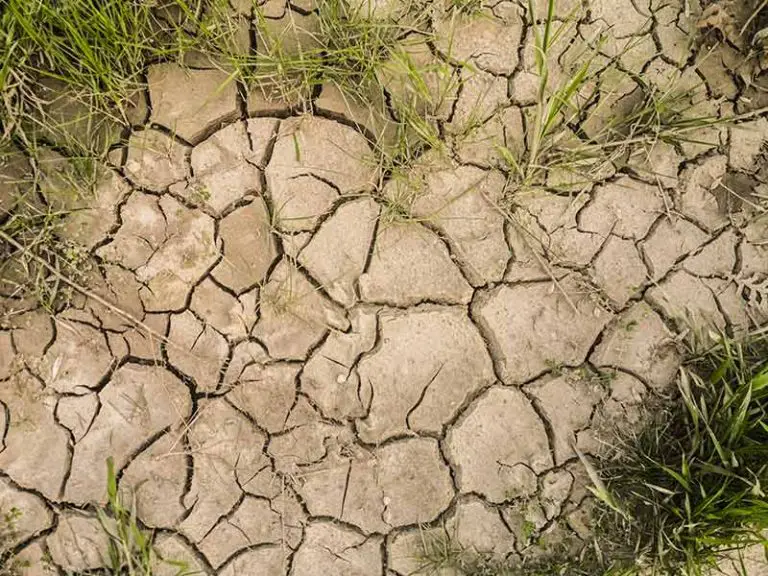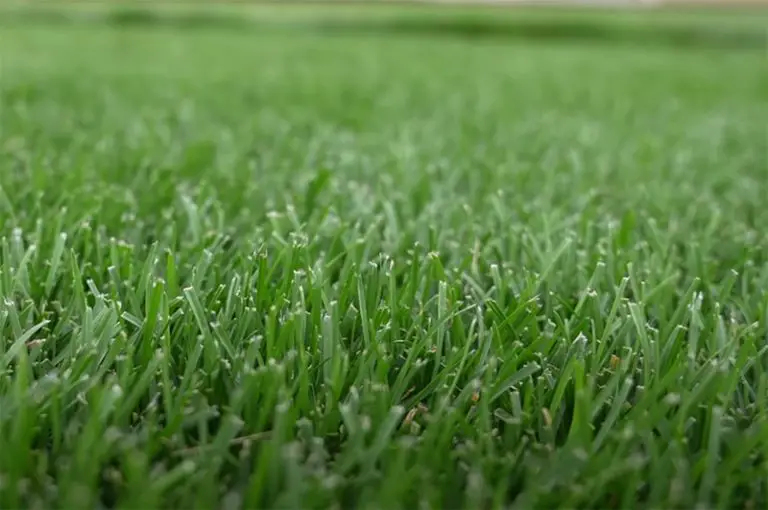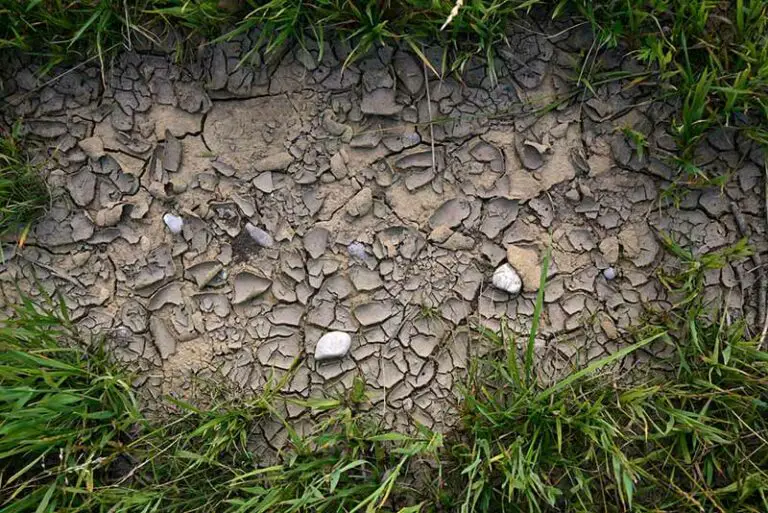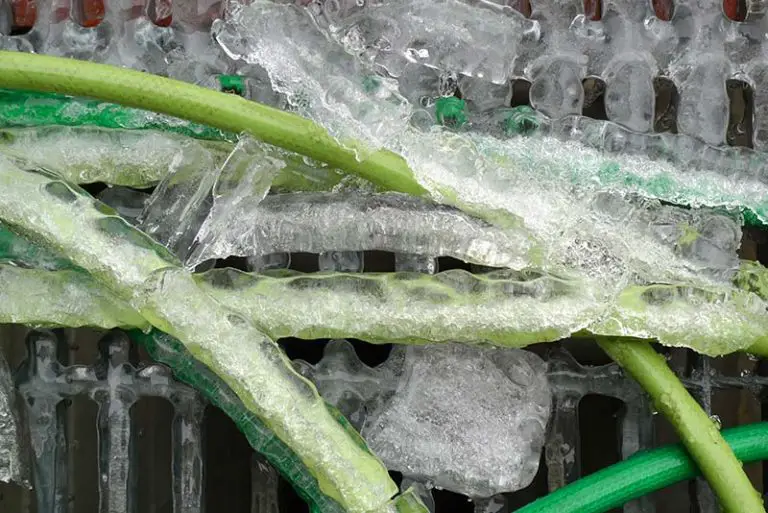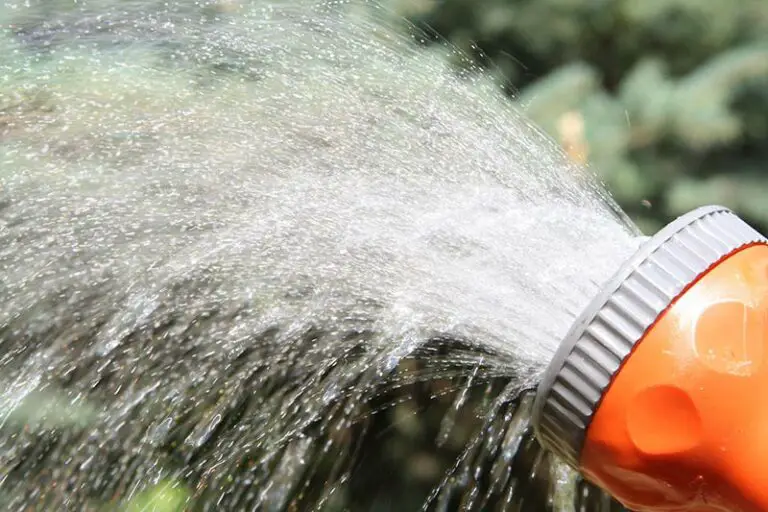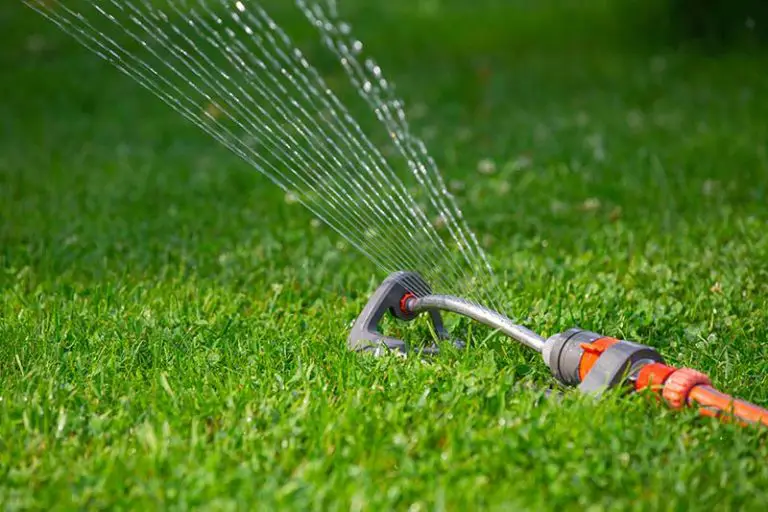Best Time to Water Grass & How Long to Water For
It doesn’t take a master gardener to know that grass needs a consistent supply of water during its season of active growth to stay alive and healthy. With that said, it can be a bit of a challenge when trying to determine the fine details of your watering schedule – the grass species, the climate and weather conditions of your area, and the age of your lawn all have an impact on when and how often you should water your lawn.
The best time to water grass is in the morning, before 10am. Generally speaking, most established lawns will require about 1 to 1.5 inches of water per week, split into one or two watering sessions. However, the exact time and amount of watering that your lawn requires will ultimately depend on a number of other factors, which we have broken down in this extensive guide. Read on to learn everything you need to know before establishing your regular watering routine for a lawn full of strong, healthy grass plants.
This article provides guidance tailored mainly for those with already established lawns – see our article How Often To Water New Grass Seed for information on when and how often to water newly planted grass seed.
Best Time to Water Grass
The best time of day to water grass is in the morning before 10am, ideally at some point between 4am and 6am. At this time of day, temperatures are cooler and there is usually little to no sunlight, which means that there’s less risk of the soil losing moisture to evaporation.
If you’re unable to water the grass before 10am, the next best time to water is between 4pm and 6pm. Absolutely avoid watering the lawn late at night – even though temperatures are cool at this time, letting so much moisture sit on your lawn overnight can leave the grass more susceptible to disease and fungal infestations.
How Long to Water Grass
For established lawns, the typical watering schedule usually requires 1 to 2 watering sessions per week, adding 1 to 1.5 inches of water per session. In terms of the length of time this takes in minutes, the exact number will vary depending on the size of your lawn, the type of sprinkler system you’re using, and the settings that the system is on.
If you’re watering with a sprinkler system, you can use one of the following methods to determine for yourself the exact number of minutes you should water your lawn:
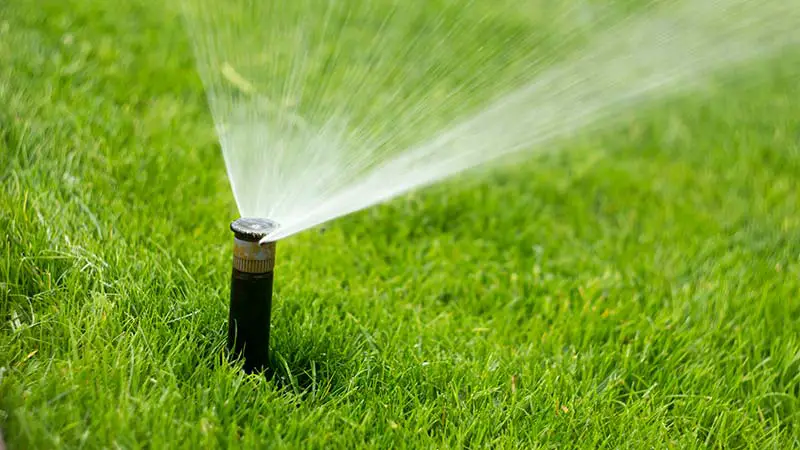
Work it Out Mathematically
This is the easiest method of determining the amount of water your sprinkler system expels, as the flow rate measured in gallons per minute can be found out from the manufacturer of your system. After finding out the flow rate, multiple the size of your lawn in square feet by 0.62 gallons (this is the equivalent of 1 inch of water per square foot of lawn), then divide the result by the sprinkler flow rate. This figure is the number of minutes that you should let your sprinkler system run.
(Size of lawn in sq feet X 0.62) ÷ sprinkler flow rate = number of minutes to water
Use a Flow Timer/Water Timer
If you’re unable to find out from the manufacturer, you can determine the flow rate of the water coming out of your sprinklers by adding a flow timer or water timer to your sprinkler line. After finding out the flow rate, you can use the same mathematical formula above to calculate the amount of minutes you should water your lawn. You’ll need to purchase a flow timer that measures the flow in hundreds of gallons.
Carry Out a Can Test
You can get a good idea of how much water your sprinkler system expells using tuna or cat food cans, or any can of a similar size. Take several clean, empty cans and place them in different spots around your lawn. Run your sprinklers, and take note of how many minutes it takes each can to collect 1 to 1.5 inches of water. Add these times together, then divide the result by the number of cans you used in order to find out the average time it takes your sprinklers to expel one inch of water.
Tip: When you get into your regular watering schedule, you may start to notice that the lawn takes a longer time to absorb water than it took at the beginning. If it gets to the point where you notice puddling on the soil surface during watering, try breaking up the total watering time into several shorter cycles; for example, if you usually water for half an hour, break this time up into 10 minutes of watering, 10 minutes off, then 10 minutes on again. This will allow the water to seep down into the soil between the cycles, thus preventing puddling from occurring.
How Much to Water Grass
As a general rule, the amount of water that you should add to your lawn is about 1 to 1.5 inches per week. With that said, the exact amount that you should water your grass depends on several factors: the grass species, the type of soil you have (whether it’s clay-heavy, sandy, hard, etc.), the age of your lawn, and the climate and weather conditions of the area you live in.
The advice we have provided below is to be used only as a rough guide to get you started with determining the best watering amounts for your lawn’s individual requirements.
For Established Lawns
Instead of determining the amount you need to water your lawn by using time or quantity of water, you should base your schedule on how often it’s necessary to water in order to keep the top 6 to 8 inches of soil consistently moist. Generally speaking, this is equivalent to about 1 to 1.5 inches of water per week, but the exact amount will vary depending on your individual situation.
Tip: The key to watering established grass for best results is to water infrequently but deeply each time. Doing so encourages the grass plants to grow deeper and stronger roots, which in turn makes them healthier and more resilient to the stress caused by drought, heat, and disease.
For Newly Seeded or Sodded Lawns
For newly seeded or sodded lawns, the aim when watering is to keep the top 1 inch of the soil consistently moist, without making it soggy or sodden. This is to promote the healthy germination and growth of the new grass seedlings. This can be achieved by watering the grass for about 10 to 15 minutes, once in the morning and once in the evening.
When the seedlings germinate, you should start to reduce the frequency of the watering sessions, but increase the amount of water you apply each time, now aiming to keep the top 2 inches of soil consistently moist. Once the grass has reached a height of about 3 inches, you should reduce the watering sessions to two times a week, soaking the soil to a depth of 6 to 8 inches as you would with an established lawn.
Tip: You can get into contact with your local Cooperative Extension Office to get exact recommendations on how much to water your grass based on your turf and the area that you live in.
How Often to Water Grass
As we’ve discussed, the general guidance is to water your lawn with about 1 to 1.5 inches of water per week. In terms of how often to water grass, this amount can be applied all in one go, or split into two watering sessions. The reason why it isn’t advisable to split this amount up into smaller, more frequent watering sessions is that doing so would prevent the grass plants from growing deep roots. By carrying out less frequent watering, but also watering more deeply each time, you’re encouraging the grass plants to reach further down into the moist soil. This results in stronger and longer roots, which in turn provides the grass plants with greater resistance to the stress brought about by heat, drought, and disease.
Tips for Watering Different Grass Types
There are two main categories that all grass types fall under: warm-season grasses and cool-season grasses. As the names suggest, warm-season grasses are better suited to withstand heat and prefer to be grown in southern regions, whereas cool-season grasses prefer cooler temperatures and tend to be grown in more northern regions.
Due to their different requirements, it’s important to factor in the type of grass you have growing in your lawn before finalizing your watering schedule. We have provided some extra tips for watering cool-season and warm-season grasses below:
How Often to Water Cool-Season Grass
Cool-season grasses include fine, tall, and creeping fescue, annual and perennial ryegrass, Kentucky bluegrass, and bentgrass.
These grasses see their most active growth in the fall, during which time they’ll need to be watered with about 1 to 1.5 inches per week, split into two watering sessions. Keep up this schedule throughout the growing season, ending when the first frost of winter sets in. If cool-season grasses aren’t watered during periods of drought, they will go brown and enter a state of dormancy until it rains again, when they will green back up.
How Often to Water Warm-Season Grass
Warm-season grasses include Bermudagrass, St. Augustine grass, centipede grass, zoysiagrass, bahiagrass, and carpetgrass
These grasses will grow most actively during the summer months and typically have lower watering requirements compared to cool-season grasses, only needing about 1 inch of water per week, split into two watering sessions. Continue this watering schedule as long as the grass keeps growing and requiring mowing. Even though warm-season grasses are better suited to warmer temperatures, they will still require a bit of extra water during periods of drought or extreme heat.
How to Tell if Grass is Underwatered
There are a few ways you can determine whether your lawn needs to be watered:
Footprints on Grass
Noticing long-lasting footprints or lawn mower tire tracks on the lawn indicates you need to up your watering schedule. As a test, use your foot to step on the grass. If it springs back straight away, it has enough water and won’t need any additional watering. If it takes a long while to spring back, or doesn’t spring back at all, this is a sign it needs to be watered.
Curled-up Grass Blades
If the established blades of grass in your lawn are starting to whither or curl up, this is a sign they aren’t getting enough water. When grass plants don’t receive enough water, they will attempt to conserve it by folding their blades into a V shape. This causes the appearance of withered, curled-up grass.
Change in Color
As we all know, healthy grass will have a lush, vibrant green color to it. When your lawn doesn’t get enough water and your grass plants start to suffer from the effects of drought stress, the blades will start to go dull and lose their color, eventually turning a shade of greyish or bluish-green. This is a sign that the grass isn’t getting enough water and that watering will be required to get the grass back to its healthy green shade.
It should be noted that seeing one or all of these signs on your lawn does not mean that the grass is about to die. Turfgrasses have the ability to turn completely brown and fall into a state of dormancy while remaining alive for around three to four weeks, only after which they will start to actually die.
How to Tell if Grass is Overwatered
Overwatering the lawn can be just as damaging, if not more so, than underwatering it. Look out for these telltale signs that your lawn is receiving more water than it needs, and reduce your watering as necessary.
Depressions in Lawn
If you notice depressions in the lawn where there has been foot traffic, this is a sign your lawn is oversaturated with water. Visible or large depressions can be corrected by leveling your lawn.
Wilting Grass
Even though wilted grass is typically a sign of underwatering, overwatering can also cause a similar problem. If your grass appears dull and faded, it doesn’t spring back after you step on it, and you definitely aren’t underwatering your lawn, then this could be a sign that it’s actually being overwatered.
Spread of Lawn Fungus or Disease
Unsightly infestations of mushrooms, algae, mold, blight, and brown patch fungus can all be indicative that your lawn is overwatered. These organisms thrive in overly damp conditions, so you should reduce your watering if you notice any of these diseases starting to develop in your lawn.
Grass Plants Have Root Rot
Root rot is another common fungal disease that is caused when there’s too much moisture in the soil. An infestation of root rot causes the roots of grass and other plants to turn gray, brown, and slimy while causing the plants’ foliage to turn yellow or brown.
Visible Water Runoff
If you can see a large amount of water runoff flowing from your yard to the surrounding sidewalks or streets, then you’re likely oversaturating the soil. The biggest issue with this is that the runoff water also contains any fertilizers or chemical treatments that you’ve added to your lawn, which then flows into the sewers and nearby environments. These chemicals can be damaging to the local wildlife, and may even end up in the local water supply – the risk of this is increased if you have a well in your yard. Noticing significant water runoff after you’ve watered the lawn is a surefire sign that it is being overwatered.
Types of Irrigation Systems
If you’re at the stage of installing a new irrigation system, there are a few different types you can use to water your lawn, from sprinklers to more advanced ‘smart’ watering solutions. They all have their own particular benefits, so the type that you choose will ultimately depend on you and your lawn’s individual requirements. We have listed some of the main types of irrigation systems below:
Hose-end Sprinklers
Hose-end sprinklers are ideal for small to medium-sized lawns. They are the traditional and most commonly used type of irrigation system and come in many varieties, meaning that there is a type to suit most lawns.
Oscillating Sprinklers
Oscillating sprinklers are recommended as a good option for newly-seeded lawns. The force of the water that they expel is weaker, however, they still provide as much coverage as other types of sprinklers.
Pulsating Sprinklers (Water Guzzlers)
Pulsating sprinklers, also known as water guzzlers, are best suited for established lawns. These sprinklers are able to cover large areas with ease, quickly providing grassroots with the amount of moisture that they need. As they work by shooting out water in a powerful, horizontal stream, pulsating sprinklers are not suitable for newly seeded or sodded lawns.
In-ground Sprinklers
In-ground sprinklers are highly efficient, but they come at a higher cost compared to other types of sprinkler systems. The sprinkler heads are automated and will pop up whenever it’s time to water, deliver a precise amount of water to the lawn, then pop back down once the watering has finished. To see the best results from these sprinklers, you should choose a system that sits low to the ground and set the sprinkler heads to water in a horizontal spray pattern.
Smart Watering Systems
Smart watering systems are the most technologically advanced option for irrigation. These systems come in many different types, with most types having the capability to integrate with other in-ground sprinkler systems. Many smart watering systems come with controls that enable you to use your smartphone to schedule watering sessions, and also have the ability to automate their own watering operations based on real-time weather data.

